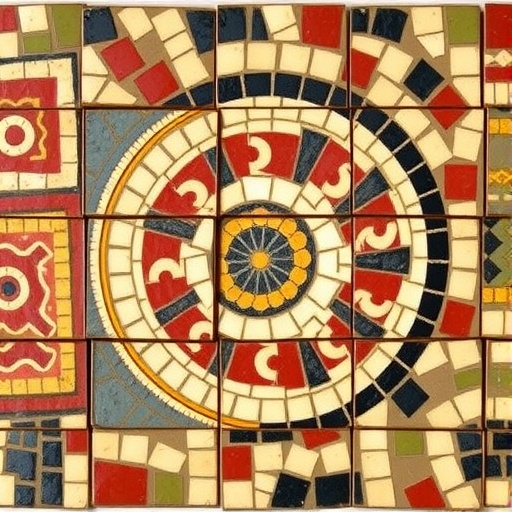In a groundbreaking study that unveils significant insights into early Byzantine artistry, researchers focused on the intricate world of glass tesserae from the 5th to 6th centuries, specifically those unearthed from the Balatlar Church in Sinop, located in Türkiye’s Black Sea region. This region, steeped in rich history, served as a crucial nexus during the Byzantine era where art and technology flourished. The study meticulously examines the characterizations of these tesserae, revealing not just a technical perspective, but also a profound narrative surrounding the cultural practices of ancient artisans.
The glass tesserae analyzed in this research showcase a remarkable array of colors, reflecting the techniques and materials utilized by artisans of the time. The researchers employed advanced analytical methodologies, including Scanning Electron Microscopy (SEM) and Energy Dispersive Spectroscopy (EDS), to dissect the chemical composition of the tesserae. These techniques allowed for a detailed understanding of the glass-making processes employed in the Byzantine period, shedding light on the raw materials sourced from local and distant locations. The results revealed that the glassmakers utilized a diverse range of mineral additives to achieve the vivid colors that characterize Byzantine glasswork.
Among the findings, it was discovered that local resources, including sand and alkalis, were extensively deployed in the creation of glass, with the influences of trade routes also evident in the elemental composition. This highlights an intriguing interplay between local craftsmanship and the broader economic networks that defined the Byzantine Empire. The tesserae from the Balatlar Church serve as a testament to the advanced knowledge possessed by these early artisans, who mastered the art of glassmaking to create intricate mosaics that adorned religious spaces.
In the context of historical significance, the Balatlar Church itself stands as an emblem of Byzantine architecture and cultural identity. Built to serve the Christian community in Sinop, the church reflects the architectural styles and artistic practices that were prevalent during the period of its construction. The glass tesserae discovered within its confines not only provide an artistic overview but also serve as a tangible link to the spiritual and communal life of the era. The findings from this study add an invaluable context to the understanding of Byzantine ecclesiastical spaces and their embellishments.
The methodological approach of the research is noteworthy, as it integrates both scientific and historical analyses. By combining archaeological context with modern scientific techniques, the authors have successfully created a multi-dimensional narrative around the tesserae. This depth of study underscores the evolution of glass-making and its religious implications, showcasing how materials can narrate stories of faith, artistry, and the passage of time.
Further complicating the narrative is the discussion surrounding the apparent decline in the quality and diversity of glass tesserae in later Byzantine periods. The researchers propose that socio-political shifts may have affected both the accessibility of raw materials and the transmission of artisanal knowledge. This aligns with wider historical trends in the Byzantine Empire, where periods of stability often yielded artistic flowering, while periods of strife precipitated decline.
In addition to addressing artistic and historical implications, the research also paves the way for future studies in material science. The data collected could lead to enhanced understanding of ancient technologies, inspiring contemporary artisans and researchers alike. The endeavor highlights the continuity of craftsmanship across millennia, illustrating how ancient methods can inform modern practices.
The historical significance of the Balatlar Church and its tesserae extends beyond mere aesthetics; it encapsulates the broader socio-religious landscape of early Byzantium. Mosaics adorned the interiors, providing visual narratives that conveyed theological themes and communal identities. Consequently, the glass tesserae not only established the artistic quality of the church’s décor but also acted as a medium for storytelling within the sacred space.
This study distinctly highlights the importance of interdisciplinary research in archaeology, revealing how scientific analysis can enrich historical interpretation. By examining these glass tesserae, the researchers have opened new avenues for understanding how artisanal practices intersect with cultural identities, thereby rewriting components of Byzantine history.
As the discourse surrounding Byzantine art continues to evolve, so too does the recognition of the essential role played by such artifacts in shaping historical narratives. The work conducted on the Sinop tesserae represents merely a single strand in the intricate tapestry of Byzantine artistry, yet its implications resonate far beyond a strict archaeological analysis.
Finally, the findings resonate with contemporary discussions on heritage conservation and the importance of understanding historical materials. They serve as a reminder of the rich artistic legacies that continue to inform current artistic practices. By delving into the past, researchers like Ormancı et al. advocate not only for the preservation of historical sites but also for a deeper appreciation of the complex narratives woven into our artistic heritage.
This exploration into Byzantine glass tesserae not only contributes to the academic field but also encapsulates an enduring human quest for beauty and meaning, transcending temporal and spatial boundaries. It is this interplay of artistry, technology, and culture that continuously fascinates scholars and enthusiasts alike, drawing them into the captivating world of Byzantine glasswork and its timeless allure.
Subject of Research:
Article Title: Materials characterization of 5th-6th century early Byzantine glass tesserae from Sinop Balatlar Church (Black Sea region, Türkiye).
Article References:
Ormancı, Ö., Köroğlu, G., Aysal, N. et al. Materials characterization of 5th-6th century early Byzantine glass tesserae from Sinop Balatlar Church (Black Sea region, Türkiye).
Archaeol Anthropol Sci 17, 202 (2025). https://doi.org/10.1007/s12520-025-02310-7
Image Credits: AI Generated
DOI: https://doi.org/10.1007/s12520-025-02310-7
Keywords:




